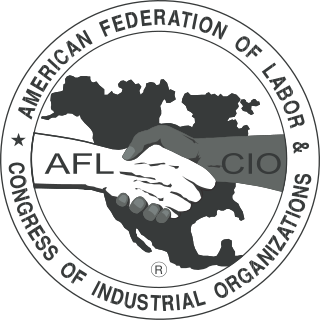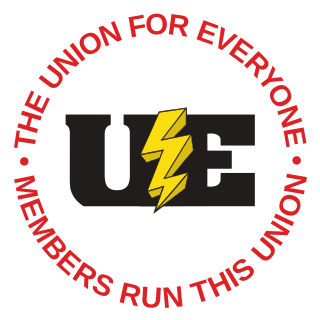Related Research Articles

The American Federation of Labor and Congress of Industrial Organizations (AFL-CIO) is a national trade union center that is the largest federation of unions in the United States. It is made up of 60 national and international unions, together representing more than 12 million active and retired workers. The AFL-CIO engages in substantial political spending and activism, typically in support of progressive and pro-labor policies.

The Communist Party (CP) and its allies played a role in the United States labor movement, particularly in the 1930s and 1940s, but largely wasn't successful either in bringing the labor movement around to its agenda or in converting their influence in any particular union into membership gains for the Party. The CP has had only negligible influence in labor since its supporters' defeat in internal union political battles in the aftermath of World War II and the Congress of Industrial Organizations's (CIO) expulsion of unions in which the party held the most influence in 1950. The expelled parties were often raided by stronger unions, and most withered away.

The American Federation of Labor was a national federation of labor unions in the United States that continues today as the AFL-CIO. It was founded in Columbus, Ohio, in 1886 by an alliance of craft unions eager to provide mutual support and disappointed in the Knights of Labor. Samuel Gompers was elected the full-time president at its founding convention and was re-elected every year except one until his death in 1924. He became the major spokesperson for the union movement.
The United Food and Commercial Workers International Union (UFCW) is a labor union representing approximately 1.3 million workers in the United States and Canada in industries including retail; meatpacking, food processing and manufacturing; hospitality; agriculture; cannabis; chemical trades; security; textile, and health care. UFCW is affiliated with the Canadian Labour Congress (CLC) and the AFL–CIO; it disaffiliated from the AFL–CIO in 2005 but reaffiliated in 2013. UFCW is also affiliated to UNI Global Union and the IUF.

The nature and power of organized labor in the United States is the outcome of historical tensions among counter-acting forces involving workplace rights, wages, working hours, political expression, labor laws, and other working conditions. Organized unions and their umbrella labor federations such as the AFL–CIO and citywide federations have competed, evolved, merged, and split against a backdrop of changing values and priorities, and periodic federal government intervention.

John Joseph Sweeney was an American labor leader who served as president of the AFL–CIO from 1995 to 2009.

The United Electrical, Radio and Machine Workers of America (UE), is an independent democratic rank-and-file labor union representing workers in both the private and public sectors across the United States.

Joseph Curran was a merchant seaman and an American labor leader. He was founding president of the National Maritime Union from 1937 to 1973, and a vice president of the Congress of Industrial Organizations (CIO).
The International Union of United Brewery, Flour, Cereal, Soft Drink and Distillery Workers was a labor union in Canada and the United States. The union merged with the Teamsters in 1973.

The Oil, Chemical and Atomic Workers Union (OCAW) was a trade union in the United States which existed between 1917 and 1999. At the time of its dissolution and merger, the International represented 80,000 workers and was affiliated with the AFL–CIO.
The Steel Workers Organizing Committee (SWOC) was one of two precursor labor organizations to the United Steelworkers. It was formed by the CIO on June 7, 1936. It disbanded in 1942 to become the United Steel Workers of America. The Steel Labor was the official paper of SWOC.
David John McDonald was an American labor leader and president of the United Steelworkers of America from 1952 to 1965.
The National Maritime Union (NMU) was an American labor union founded in May 1937. It affiliated with the Congress of Industrial Organizations (CIO) in July 1937. After a failed merger with a different maritime group in 1988, the union merged with the Seafarers International Union of North America in 2001.

Emil Rieve was an American labor leader. He was president of the Textile Workers Union of America (TWUA) from 1939 to 1956, a vice president of the Congress of Industrial Organizations (CIO) from 1939 to 1955, and a vice president of the AFL-CIO from 1955 to 1960.
The United Public Workers of America (1946–1952) was an American labor union representing federal, state, county, and local government employees. The union challenged the constitutionality of the Hatch Act of 1939, which prohibited federal executive branch employees from engaging in politics. In United Public Workers of America v. Mitchell, 330 U.S. 75 (1947), the Supreme Court of the United States upheld the Hatch Act, finding that its infringement on the Constitutional rights was outweighed by the need to end political corruption. The union's leadership was Communist, and in a famous purge the union was ejected from its parent trade union federation, the Congress of Industrial Organizations, in 1950.

The Pennsylvania AFL–CIO is a federation of labor unions in the U.S. state of Pennsylvania in the United States. It is an affiliate of the AFL–CIO. It was formed on June 9, 1960, by the merger of two predecessor bodies, the Pennsylvania Federation of Labor and the Pennsylvania Industrial Union Council. It can trace its history through its predecessor bodies to 1890.

The Congress of Industrial Organizations (CIO) was a federation of unions that organized workers in industrial unions in the United States and Canada from 1935 to 1955. Originally created in 1935 as a committee within the American Federation of Labor (AFL) by John L. Lewis, a leader of the United Mine Workers (UMW), and called the Committee for Industrial Organization. Its name was changed in 1938 when it broke away from the AFL. It focused on organizing unskilled workers, who had been ignored by most of the AFL unions.
The Metal and Machinery Workers Industrial Union No. 440 (MMWIU) was a labor union in the United States which existed from 1907 to 1950. It organized workers in the manufacturing industry and was affiliated with the Industrial Workers of the World (IWW).
The United Office and Professional Workers of America (UOPWA) (1937–1950) was a CIO-affiliated union and one of the white-collar unions formed by the CPUSA-breakaway party of Lovestoneites.
References
- ↑ Reynolds, Lloyd G.; Killingsworth, Charles C. (1944). Trade Union Publications: The Official Journals, Convention Proceedings, and Constitutions of International Unions and Federations, 1850–1941. Baltimore: Johns Hopkins Press.
- ↑ Directory of Labor Unions in the United States (PDF). Washington DC: United States Department of Labor. 1950. Retrieved 11 July 2022.
- ↑ Stepan-Norris, Judith; Zeitlin, Norris (2003). Left Out: Reds and America's Industrial Unions. Cambridge: Cambridge University Press. ISBN 052179840X.